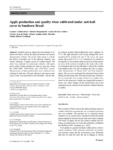Use este identificador para citar ou linkar para este item:
http://www.alice.cnptia.embrapa.br/alice/handle/doc/998047Registro completo de metadados
| Campo DC | Valor | Idioma |
|---|---|---|
| dc.contributor.author | BOSCO, L. C. | pt_BR |
| dc.contributor.author | BERGAMASCHI, H. | pt_BR |
| dc.contributor.author | CARDOSO, L. S. | pt_BR |
| dc.contributor.author | PAULA, V. A. de | pt_BR |
| dc.contributor.author | MARODIN, G. A. B. | pt_BR |
| dc.contributor.author | NACHTIGALL, G. R. | pt_BR |
| dc.date.accessioned | 2016-02-22T12:39:38Z | - |
| dc.date.available | 2016-02-22T12:39:38Z | - |
| dc.date.created | 2014-10-22 | pt_BR |
| dc.date.issued | 2014 | pt_BR |
| dc.identifier.citation | International Journal of Biometeorology, Sept. 2014. | pt_BR |
| dc.identifier.uri | http://www.alice.cnptia.embrapa.br/alice/handle/doc/998047 | pt_BR |
| dc.description | Anti-hail nets may change the microclimate of orchards and hence modify the physicochemical and sensory characteristics of fruits. The present study aimed to evaluate the effects of anti-hail nets on the physical, chemical, and sensory attributes of apples grown in southern Brazil. The study was conducted in commercial orchards, with apples grown under a black anti-hail net under an open sky during the 2008/2009, 2009/2010, and 2010/2011 cycles. Measurements of photosynthetically active radiation were collected at both sites. Physical, chemical, and sensory analyses of fruits were performed in the laboratory. The anti-hail net reduced incident photosynthetically active radiation by 32 %. The light spectrum in the canopy changed the corresponding R/FR (red/far-red) ratio in the lower and upper canopy layers from 0.27 to 1.55, respectively. In contrast to the majority of microclimate studies carried out in the temperate zones of the northern hemisphere, this study in the southern hemisphere showed that although it reduced the incident solar radiation, the cover did not change the color or organoleptic characteristics of ?Royal Gala? and ?Fuji Suprema? apples. The net cover prolonged the subperiod between fruit setting and harvesting, thus slowing fruit ripening. Therefore, the use of anti-hail nets on apple orchards is a suitable alternative for the protection of apple trees against hail because it causes only small changes in the microclimate and in the maturation period, ensuring fruit production without affecting its quality. | pt_BR |
| dc.language.iso | eng | eng |
| dc.rights | openAccess | eng |
| dc.title | Apple production and quality when cultivated under anti-hail cover in Southern Brazil. | pt_BR |
| dc.type | Artigo de periódico | pt_BR |
| dc.date.updated | 2019-04-02T11:11:11Z | pt_BR |
| dc.subject.thesagro | Maçã | pt_BR |
| dc.subject.nalthesaurus | Apples | pt_BR |
| riaa.ainfo.id | 998047 | pt_BR |
| riaa.ainfo.lastupdate | 2019-04-02 -03:00:00 | pt_BR |
| dc.identifier.doi | 10.1007/s00484-014-0893-6 | pt_BR |
| dc.contributor.institution | GILMAR RIBEIRO NACHTIGALL, CNPUV. | pt_BR |
| Aparece nas coleções: | Artigo em periódico indexado (CNPUV)  | |
Arquivos associados a este item:
| Arquivo | Descrição | Tamanho | Formato | |
|---|---|---|---|---|
| NachtigallIJB.pdf | 475,12 kB | Adobe PDF |  Visualizar/Abrir |









